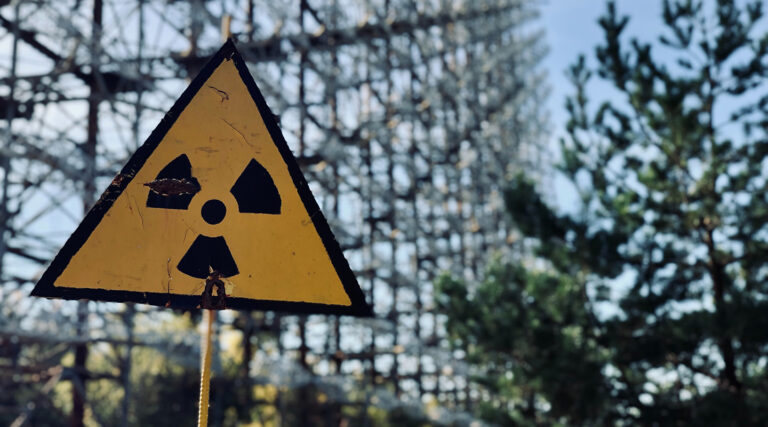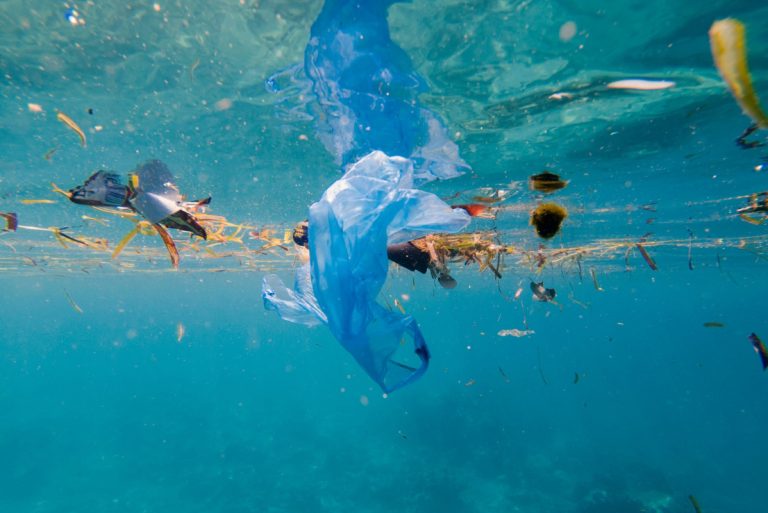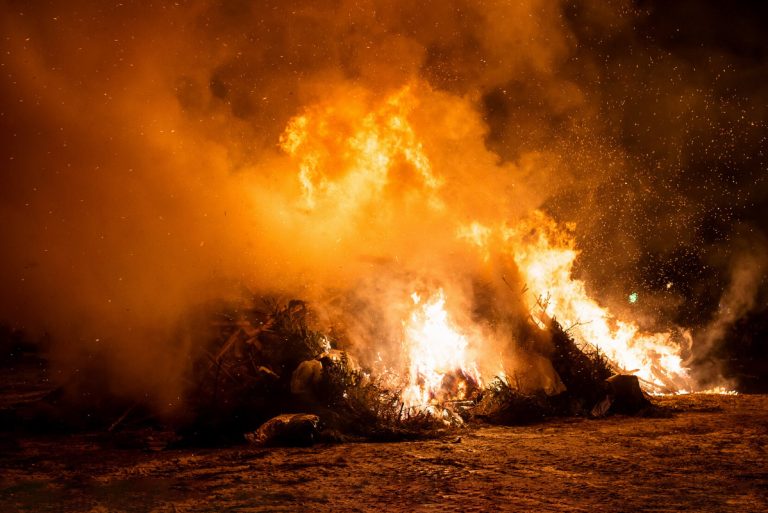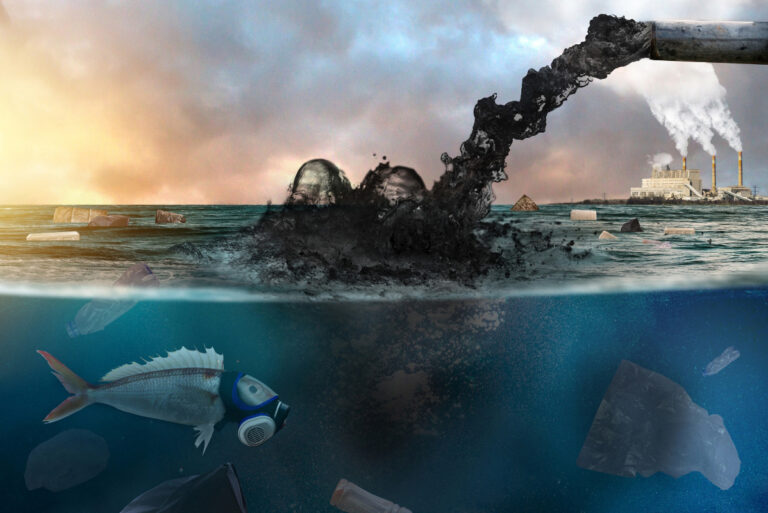For over 60 years, nuclear radiation and radioactive pollution have been major environmental concerns. The proliferation of nuclear material has been driven by its use in energy generation, healthcare, and wide-ranging industry and defense applications generating at least 2,000 tons of waste each year in the US alone.
Disposing of nuclear waste and managing natural and manufactured radiation sources in our environment is difficult. If inadequately contained, radioactive waste and pollution can cause serious health problems and long-term environmental contamination.
To help you understand the serious implications of nuclear radiation and radioactive pollution, this article closely examines the causes, effects, and solutions to nuclear radiation.
What is radioactive pollution?
The International Atomic Energy Agency (IAEA) defines radioactive pollution as the unintended or undesirable presence or deposition of radioactive substances on surfaces or within solids, liquids, and gasses. For this article, radioactive pollution and radiological contamination will be used interchangeably.
The contamination of land, air, seas, and freshwater with radioactive contaminants introduces these environments and the living things within them to ionizing radiation generated by the decay of radioactive material.
The unstable nuclear state of radioactive elements leads to their degradation releasing hazardous energy in the form of alpha, beta, and gamma rays along with free neutrons.

Radioactive waste and pollutants vary in their level of radioactivity and capacity to harm. But sustained contact with the bodily organs of humans and animals can lead to tissue damage, disease, genetic mutations, cancers, and death.
One of the big problems with radioactive pollution is that it is persistent, with radioactive substances releasing damaging radiation for decades or even centuries after the contaminating incident depending on the half-life of the contaminant.
Radioactive waste is a major source of nuclear radiation pollution
According to the Environmental Protection Agency (EPA), there are five types of radioactive waste:
1. High-level waste
High-level nuclear waste is the most dangerous and toxic form of nuclear waste. Only 1% of all radioactive waste is high-level waste. Its hazardous nature means that it is usually stored at the facility where it is generated. High-level nuclear waste primarily comes from two sources:
- Solid spent nuclear fuels: the majority of high-level waste.
- Liquid high-level waste from defense activities.

Source: Wikimedia / United States Department of Energy
2. Transuranic waste
Transuranic waste is a special category of radioactive waste derived from manufacturing nuclear fuels and weapons. This type of waste is generated by man-made radioactive elements with an atomic number of 92 or higher. This waste is so dangerous that disposable items associated with its development must be stored at a remote Waste Isolation Pilot Plant (WIPP).
3. Mill tailings
As mentioned below, mill tailings are solid wastes left over from uranium and thorium processing. These highly radioactive discarded materials require sealed storage at a dedicated facility.
4. Technologically enhanced naturally-occurring radioactive material (TENORM)
TENORM materials are naturally occurring radiological materials (NORM) that man has enhanced through processes like enrichment, with various uses in industry. TENORM materials are less potent than high-level waste but require careful disposal in-line with state regulations.
5. Low-level waste
Low-level radioactive waste is generated by industry, healthcare, and defense. Low-level and very low-level waste account for over 95% of the total amount of radioactive waste generated.
It usually consists of disposable items in contact with radioactive materials or sources. Though they are not as dangerous as the other classes of radioactive waste, they still require disposal by specialist companies at a designated disposal facility.

Source: Wikimedia / ShinRyu Forgers
Key sources of radioactive waste and pollution
Nuclear radiation has wide-ranging positive and negative applications in the modern world. Radioactive waste is a byproduct of its use. As 10% of the world’s energy consumption is nuclear generated, radioactive elements, materials, and waste are found in every continent, along with the potential for significant pollution.
Here are the most important sources of radioactive waste today:
1. The nuclear energy sector
Nuclear energy generation generates radioactive waste, which can be low-level or high-level. Nuclear waste is a pernicious and environmental pollutant that comes from the following sources in the production of nuclear energy:
A. Uranium mill tailings
Uranium-235 is the primary driver of the nuclear reaction that is used to generate electricity. Uranium ore is milled to purify it for use in the energy sector. However, this process generates mill tailings, a waste product with more than 85% of the radioactivity of the original ore.

Source: Wikimedia / U.S. Department of Energy
Tailings have only recently been recognized as high-risk radioactive waste. This means that disposal plans for mill tailings were inadequate for many decades, leading to pollution of the surrounding environment.
B. Spent nuclear reactor fuel
Once nuclear fuel has been exhausted through use in a reactor, it is known as spent fuel. The uranium oxide used to generate nuclear energy is packaged in tiny ceramic pellets stacked with metallic rods known as fuel rods.
Spent rods are solid when removed from a nuclear reactor and require particular disposal in a spent fuel tank at the nuclear power plant. In the US, over 2,000 tons of spent fuel is generated each year, a volume that could fill half of an Olympic-sized swimming pool.
C. Tools and equipment
Any equipment that comes into contact with radioactive dust or particulate matter at nuclear processing facilities and power plants also requires careful disposal.
2. Nuclear accidents
The International Atomic Energy Agency (IAEA) defines nuclear accidents as events where large amounts of radioactive material are dispersed, leading to significant consequences to nuclear facilities, the environment, and people.
Nuclear accidents vary in severity and impact on the environment. In major nuclear accidents like the 1986 Chornobyl disaster and the 2011 Fukushima nuclear accident, the core of a nuclear reactor has been damaged, leading to the massive release of radioisotopes into the surrounding environment.
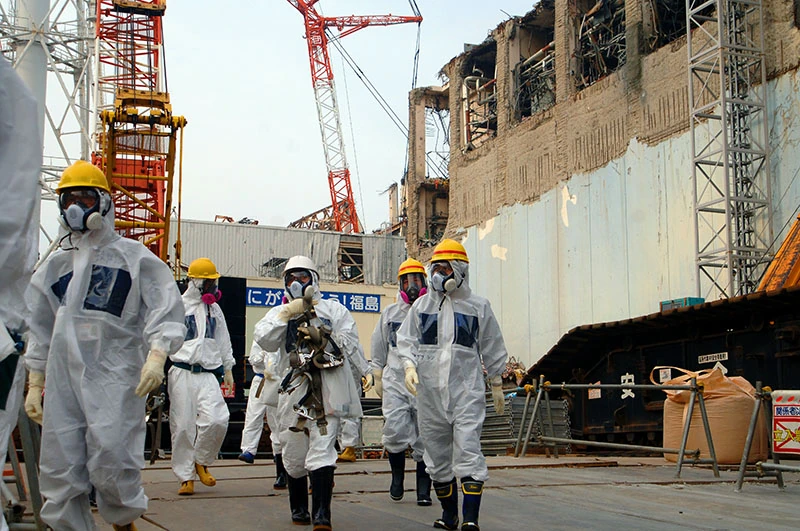
Source: Wikimedia / IAEA Imagebank
Since Chornobyl, there have been more than 57 nuclear accidents and severe incidents worldwide. 60% of these have taken place in the United States. Though many risk mitigation procedures are in place at nuclear power plants, facilities, and nuclear submarines, human error remains a major cause of nuclear accidents.
Nuclear accidents have a massive ecological impact that can have immediate and long-term effects. The radioactive pollution of land, water, and air can take decades to clean up and bring to safe levels.
3. The defense sector
In countries that have a military with nuclear capabilities, defense activities will generate nuclear waste which is usually uranium or plutonium-based but not the products of nuclear fission.
Nuclear weapons, submarines, and other military equipment become significant nuclear waste sources when decommissioned.
Nuclear waste from defense activities may take the following forms:
- Reactor components used in the development, testing, and deployment of nuclear submarines.
- Filters and resins that have come into contact with radioactive equipment.
- Liquids that have been used to cool fuel rods and other components.
- Personal protective equipment (PPE) and equipment used during the manufacture, operation, and decommissioning of nuclear weapons or energy-generating equipment.
- Depleted uranium munitions.
- Targets and ground that have been contaminated by weapons testing.
Radioactive pollution from nuclear testing
Nuclear testing has been an infamous cause of radioactive pollution. Though the last ‘known’ nuclear tests were carried out by America, the United Kingdom, and the Soviet Union in the 1990s, the pollution of land, water, and airspace can be persistent.
This is because 15% of the total energy of a nuclear explosion is radiation, with the dispersal of radionuclides that emit radiation as they degrade. The Comprehensive Nuclear Test Ban Treaty was signed in 1996.
3. Radon gas emissions
Radon gas is a naturally occurring source of radiation. It is colorless, odorless, and tasteless. Radon is one of the largest contributors to background radiation and is leached from uranium present in granite, shale, and other rocks. In regions that have high concentrations of radon, the gas can build up in properties, increasing the risk of cancer.
There is a strong association between radon gas and lung cancer. Alaska, South Dakota, and Pennsylvania have some of the highest radon gas concentrations in the U.S.

Source: Wikimedia / US EPA
4. Radioactive sources used in industry
One of the most vulnerable areas to radioactive pollution and significant human harm is the use of radioactive sources in industry. Radioactive sources used in industry have caused numerous fatal incidents because of improper storage, handling, and loss, like the Mexico City radiation accident (1962) and the Rio Tinto Western Australian radioactive capsule incident in 2023.
Radioactive sources and capsules are used in industry in the following ways:
A. Inspection
Radioactive sources are used in various manufacturing industries to inspect the integrity of fabrication, such as welding. Like an X-ray, the radioactive source is placed on one side and a detector on the other to look at how materials are penetrated. This provides a convenient and portable method for inspecting items without risking internal damage.
B. Tracers
Industrial tracers use radiation to monitor the flow of fluids and the efficiency of industrial processes such as refining. The short-lived radioisotopes that are used present minimal risk to the environment. The tracer radioisotopes are mixed in with flowing or filtered materials to track their movement and identify leaks or blockages.
C. Gauges
Gamma sources are used as gauges to monitor levels of a variety of solids, liquids, and gasses used in industry. They are advantageous in extremely hazardous environments where extremes of temperature or corrosive substances make the use of direct contact gauges impossible.
5. Medical radioisotopes from nuclear medicine
Radioactive waste is also generated by tertiary hospitals that have a nuclear medicine department. The following radioisotopes are used in diagnostic and therapeutic procedures:
- Technetium-99m (Tc-99m)
- Iodine-131(I-131)
- Carbon-14(C-14)
- Iodine-125 (I-125)
- Tritium (H-3)
- Fluorine-18(F-18)

Source: Wikimedia / Hg6996
This medical application of radiation generates not only used isotopes, but also contaminated syringes, vials, needles, swabs, vials, and dressings. Clothing and items handled by patients that have received high doses of radioisotopes may also have to be disposed of as radioactive waste.
6. Milling and mining
The mining and milling of uranium are important causes of radioactive pollution. Radioactive waste is generated in this industry via the following extraction methods:
- Open and closed-pit mining with the digging of soil and rocks out of open pits to extract uranium ore, known as carnotite.
- Leaching: a common and extremely polluting method that uses pumped chemicals to dissolve and extract uranium from rocks. The generated uranium-rich leachate is then processed to purify and extract uranium.
The waste generated from uranium mining is called tailings if it is solid and raffinates if it is liquid. This waste requires careful storage as it is some of the most hazardous waste.
In addition, the mining of any rock generates raised concentrations of radon gas that can cause lung cancer. To mitigate this radiation hazard, radon gas must be pumped out of mines, with some miners requiring breathing equipment to protect their lungs.

Source: Wikimedia / Ikiwaner
7. Improper radioactive waste disposal
Radioactive waste that has been improperly disposed of is an immediate environmental hazard. The disposal of radioactive waste is undertaken at secure specialist facilities that are regulated by the EPA, The U.S. Nuclear Regulatory Commission (NRC), and The U.S. Department of Energy (DOE).
Standards regarding the disposal and long-term storage of radioactive waste are so stringent that incidents of improper disposal have been rare recently. In the early 20th century, significant radioactive pollution was caused by the inadvertent spread of radioisotopes by radium watch dial painters, miners, and scientists like Marie Curie.
A major concern remains the longevity of storage arrangements for radioactive materials due to materials such as plutonium and uranium remaining radioactive potential for thousands of years. Earthquakes, explosions, and improper documentation have been cited as causes of radioactive waste leakages.
What are the effects of nuclear waste and radioactive pollution?
Radiation pollution is harmful because of its pervasive effects on living things. Even physically small quantities of highly radioactive materials can deliver a dose of radiation that can kill. Solid, liquid, and gaseous radioactive substances contaminate the areas where they are present and, if uncontained, will disperse through the environment.
Here are the main effects of radiation:
Effects of ionizing radiation on human health
Ionizing radiation releases radiation that penetrates human tissues and can damage the genetic material within a cell’s nucleus. The severity of these effects depends on the radiation dose and exposure duration.
Acute effects of radioactive contamination
Exposure to large doses of radiation causes Acute Radiation Syndrome, also known as radiation sickness. The energy delivered can be large enough to cause visible reddening and burns, followed by nausea, vomiting, inflammation, bleeding of the mucous membranes, hair loss, and death. The dose of radiation delivered would have to exceed 18,000 chest X-rays.
Chronic and long-term effects of radiation pollution
Sustained or chronic exposure to raised radiation levels is a significant health risk. Even if the dose is low, the proximity to a source of ionizing radiation leads to cellular and DNA damage that raises the risk of developing cancer or infertility.
Chronic effects can be experienced through occupational exposure, living in an environment, or ingesting food contaminated with radioactive materials.
Effects of radiation pollution on wildlife
Wildlife that comes into contact with nuclear fallout or the radioactive discharges from nuclear disasters can be affected similarly to humans. Genetic damage to animals can lead to mutations, especially in rodents and other small, fast-multiplying creatures.
Dispersal of radioactive particulates on grass and other vegetation can lead to radioactive materials entering the food chain and becoming concentrated in humans and apex predators.
Effects of radioactive pollution on marine life
Radioactive pollution can also harm marine environments and be dispersed through water systems over wide distances. A serious consequence is that radioactive isotopes like iodine are absorbed by seaweeds and phytoplankton, entering the marine food chain and becoming concentrated in fish and seafood.
Currently, this is one of the major concerns of the Fukushima Daiichi nuclear power plant incident. Thousands of tons of radioactive water have been released into the Pacific Ocean, with a temporary fishing ban in waters off the northeastern coast of Japan.
Despite being diluted by massive volumes of ocean water, tuna caught off the U.S. West Coast were found to have raised levels of 134Cs in their tissues.
Contaminated land
Nuclear incidents in a specific geographical area can render land unusable for decades. The soils, water, and vegetation become contaminated, leading to raised background levels of traditions that are unsafe for human habitation. Even where cleanup efforts have been successful, a geographical region may be associated with pollution and avoided by people.
Solutions for managing nuclear waste and radioactive pollution
There is no way in which radioactive pollution or waste can be physically cleaned or destroyed. Where there is contamination or a spill, ‘clean up’ efforts focus on stripping and containing contaminated materials, including buildings, vegetation, and soils. This makes careful management of radioactive waste essential. Here are the main principles:
- Careful planning: sites that handle radioactive materials use careful planning to minimize the amount of waste produced.
- Prompt processing of radioactive waste: waste is treated as soon as possible after it is generated to minimize the risk of dispersal of radioactive material. Processes are often automated, including decontamination, compacting, and solidifying radioactive waste.
- Containment of radioactive material: Nuclear waste requires specialist packaging in containers that will not allow the radiation to escape. Secure sealed containment must also be robust enough to withstand handling and transport to a storage facility.
- Reliable long-term storage: Certain radioisotopes have half-lives that can be hundreds of years. Without a safe means of disposal, most high-level radioactive waste has to be stored long-term or permanently in facilities that can be adequately sealed and secured. Storage facilities may be located underground, taking advantage of natural rock as a barrier.
The management of radioactive waste depends on its type
The approach to managing radioactive waste varies according to whether it is high-level, intermediate-level, or low-level:
High-level nuclear waste
The most hazardous forms of nuclear waste are often liquids generated while processing spent fuel rods from nuclear reactors.
This toxic liquid undergoes vitrification, where it is mixed with crushed glass and heated to become a molten liquid. The high-level waste is then poured into 150-liter stainless steel canisters and moved for long-term storage.
Waste is usually stored on-site for several decades until it is deemed safe enough for longer-term storage, usually within several other containers in a dedicated deep geological facility called a repository.
Low-level nuclear waste
Low-level nuclear waste may be incinerated and compacted for storage in many repositories. After being encased in metal containers, low-level waste is stored in concrete-lined vaults and repositories that are carefully monitored.
Most low-level radioactive waste facilities have limits on radiation levels that can safely be accepted. Regulators and regional authorities set limits on the amount of low-level waste that can be stored in a specific area. Some very low-level radioactive waste may even be landfilled.
Recovery and reprocessing of nuclear materials
Nuclear materials can also be recovered from apparent waste for future use. Uranium and plutonium are valuable and so waste that is rich in these radioactive elements is routinely stored for future use.
Spent nuclear fuel is also reprocessed using dangerous chemical processes that separate the plutonium and uranium from used fuel rods. Though this potentially reduces demand for newly mined radioisotopes, it is a potentially hazardous and polluting procedure.
Rounding up
Nuclear radiation and radioactive pollution are serious environmental issues. The continued adoption of nuclear energy (with more than 400 power stations globally) means that the amount of waste generated and the potential for pollution will also continue to increase.
Manufactured containment measures for radioactive material appear to be working well. Still, the potential for human error, natural disasters, or activity by malicious agents mean that everyone is at risk of the effects and environmental damage from this extremely dangerous type of pollution.
